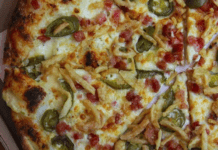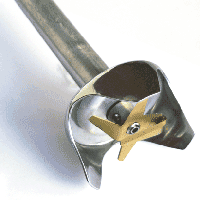Continuous food cutters and vertical cutter mixers process food at the flick of a switch.
Chopping, dicing or slicing is no sweat for chefs with formidable knife skills, but at some point, every toque relishes a little help from a food processor. Two basic types of units fit the bill: continuous feed cutters, with adjustable blades and cutting grids, which are ideal for slicing, dicing, grating and shredding; and vertical cutter mixers (VCMs), best suited for puréeing, mixing dough and emulsifying dressings.
CONTINUOUS FEED CUTTERS
Continuous feed cutters can be self-contained with their own motor or specified as attachments for planetary mixers. The ease with which the blades can be assembled and removed for cleaning is an important purchasing consideration, as is the design of the hopper— the tube that feeds the food into the unit. Angled hoppers make it safer and more comfortable to load the fare, while also making clean up easier and faster.
The cutter’s housing is usually comprised of cast aluminum or high-impact plastic for durability and straight blades and shredder/grater plates made of stainless steel, which will stay sharper longer since the blade won’t corrode as it reacts with food acids.
Motors vary from 1/3 horsepower for small table- top units to five horsepower for large floor models, with the most popular and versatile motors ranging in size from 1/3 to 3/4 hp. But bigger isn’t necessarily better, since the design of the unit and the way the motor works with the blades and the hopper is as important as raw power. Conversely, when processing soft or delicate products, the rotation speed of the motor — between 1,500 rpm and 3,600 rpm for most VCMs — is very important. While ideal for puréeing foods and emulsifying salad dressings, it’s too fast for slicing and dicing soft products more uniformly processed at speeds of 400 to 450 rpm.
VERTICAL CUTTER MIXERS
Vertical cuttermixers have amixing bowl with amotor mounted on the bottom and the shaft of the motor protruding from the bottom of the bowl, while a removable cutting blade mounts onto the shaft. These mixers are usually equipped with a clamp-down lid, made of transparent material or a metal lid with a viewing portal, and range in size fromfive-quart to 20-quart for countertop units to 25- to 130-quart for floor models. Motors range from 1/3 hp for the smallest countertop to 25 hp for the largest floor models.
Since VCMs are primarily used for puréeing, chopping and mixing, the blade needs to rotate quickly, with speed ranging from 1,500 rpm to 3,600 rpm. However, it’s important to choose the machine that best suits your needs. For example, if you are using a VCM primarily for salad dressings, then higher rpm is advisable for better emulsification of the product. If most of your use is for kneading dough, preparing sauces and chopping, then a lower rpm model is best.
Many VCMs blades are ‘S’ shaped and located at the bottom of the bowl for an efficient cutting action, which brings most of the blade in contact with the ingredient in question. Look for a transparent lid and pulse setting — so you can see and control the process — and a rotating baffle that scoops food from the edge of the bowl toward the blade with variable motor speed that provides greater versatility.
Another popular VCM is the spinning bowl or “buffalo” cutter. The tabletop units consist of a stainless bowl, which rotates the product through stationary cutting blades. This is ideal for foods that need to be chopped quickly and allows the operator to add ingredients and seasonings at intervals.
SAFETY AND SANITATION
Since continuous feed cutters and VCMs operate with sharp blades rotating at high speed, magnetic safety switches and safety interlocks are essential. Check to ensure the unit you are purchasing has extensive safety features to protect the operator. The motor of aVCMshould shut off when the lid is opened, for example.As with any complicated piece of equipment, there should be a start-up demonstration by the manufacturer’s rep for staff to be trained on proper use and safety.
Most manufacturers advise against washing the bowls and blades in commercial dishwashers, as it’s dangerous and can dull the blades quickly. Instead, grab safety gloves and wash the parts with mild detergent and a brush, air drying to avoid too much wear and tear and to prolong the life of the equipment.
OTHER OPTIONS
Although not technically food processors, hand-held mixer-blenders, or immersion blenders, have become very popular in the last few years.Available in a variety of sizes, ranging from12 to 22 inches in shaft length, these powerful machines can emulsify, purée and blend large quantities of product in a very short time. They can also be ordered with interchangeable attachments such as a potato ricer, which can be useful formaking large quantities ofmashed or whipped potatoes. Puréeing and blending cream soups is a snap with one of these machines; even salad dressings and cold sauces can be prepared in a fraction of the time it would take with conventionalmethods.
A relative newcomer to the industry is Thermomix. The specialty unit incorporates traditional food-processing functions, such as chopping, puréeing and blending, with cooking functions, so food can be cooked while being processed. Items such as custards, hollandaise sauce, puréed soups, salad dressings and dough can be made in one unit with pinpoint temperature control, ranging from between 37°C and 120°C.
Automated equipment has its advantages, but hand-operated choppers and cutters can do almost anything their mechanized counterparts can do on a smaller scale, while cutting food up faster and more uniformly than with a knife.
Manual processors can range from a basic mandolin to manually operated dicers and choppers. A mandolin is a traditional kitchen tool with a stainless steel platform and several blades for making uniform slices or specialty cuts of vegetables and fruits. Manual cutters are generally made of cast aluminum with stainless blades and push the product through the blades for slicing or compress it between a block and grid of blades for dicing and chopping. There are special cutters for wedges of citrus, lettuce cutters for heads of iceberg lettuce, and potato cutters for any size of french fry, from 1/8” shoestring to large steak fries, as well as spiral and specialty cutters.



















